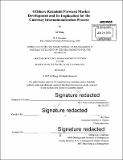| dc.contributor.advisor | Hui Chen. | en_US |
| dc.contributor.author | Wang, Xi, S.M. Massachusetts Institute of Technology | en_US |
| dc.contributor.other | Sloan School of Management. | en_US |
| dc.date.accessioned | 2015-09-29T18:57:03Z | |
| dc.date.available | 2015-09-29T18:57:03Z | |
| dc.date.copyright | 2015 | en_US |
| dc.date.issued | 2015 | en_US |
| dc.identifier.uri | http://hdl.handle.net/1721.1/98989 | |
| dc.description | Thesis: S.M. in Management Research, Massachusetts Institute of Technology, Sloan School of Management, 2015. | en_US |
| dc.description | Cataloged from PDF version of thesis. | en_US |
| dc.description | Includes bibliographical references. | en_US |
| dc.description.abstract | China has become the second-largest economy by nominal GDP and the world's largest economy after adjusting purchasing power by the end of 20141. Meanwhile, China is also the largest trading nation in the world. Since the late 2000s, the People's Bank of China (PBoC) has sought to internationalize the renminbi, the official currency of China, to improve the international use of the renminbi and in turn to stimulate monetary efficiency. The offshore renminbi market officially launched in Hong Kong SAR in July 2010 and the offshore deliverable forward market was established two months later. This paper aims to provide a detailed review of the renminbi internationalization process, particularly the foreign exchange market, including the deliverable forward market in the offshore setting. The review will test the correlations among the onshore deliverable forwards, the offshore deliverable forwards, and non-deliverable forwards by conducting time-series analyses. Moreover, interest rate parity theory is utilized to price the theoretical offshore deliverable forwards. Substantial deviations are observed and documented between the theoretical and actual offshore deliverable forward rates. Furthermore, regression analyses are adopted to provide empirical evidence to explain the possible reasons affecting the prices of the offshore renminbi deliverable forwards and the onshore deliverable forwards, also, the price differential between these two products. Among these reasons, exchange rate expectation, macroeconomic sentiment and market liquidity show statistically significant impact. Finally, the paper will discuss the possible implications of the preceding analyses for the development of the offshore deliverable forward market and the renminbi internationalization process. | en_US |
| dc.description.statementofresponsibility | by Xi Wang. | en_US |
| dc.format.extent | 31 pages | en_US |
| dc.language.iso | eng | en_US |
| dc.publisher | Massachusetts Institute of Technology | en_US |
| dc.rights | M.I.T. theses are protected by copyright. They may be viewed from this source for any purpose, but reproduction or distribution in any format is prohibited without written permission. See provided URL for inquiries about permission. | en_US |
| dc.rights.uri | http://dspace.mit.edu/handle/1721.1/7582 | en_US |
| dc.subject | Sloan School of Management. | en_US |
| dc.title | Offshore renminbi forward market development and its implication for the currency internationalization process | en_US |
| dc.type | Thesis | en_US |
| dc.description.degree | S.M. in Management Research | en_US |
| dc.contributor.department | Sloan School of Management | |
| dc.identifier.oclc | 921180589 | en_US |
